by Rafif Mahmoud
Introduction
The tacit goal in destroying symbolically important objects is to sap enemy morale. In most discussions of this phenomenon, the emphasis has been on the deliberate destruction of places of high art, a monument of historical and religious importance, libraries, and museums containing portable works of art- in other words, those places that are of high symbolic value and whose destruction is believed would cause the greatest despair.[1]
The loss of cultural heritage has been devastating in the aggressive civil war in Syria, most notably in World Heritage sites, the conflict has resulted in the devastation of the country’s acclaimed cultural heritage sites, and the historical fabric that composed the country’s social landscape and the identity of its population. However, it is now widely acknowledged that the destruction of cultural heritage plays a significant role in and of itself in modern conflicts, affecting entire societies, as it is linked to the destruction of group identity, when it took a form of smashing artifacts in archaeological museums, iconoclastic breaking, bulldozing of archaeologist sites, dynamiting holy sites of local communities. And this in turn affects identity, collective memory and belonging over time. Thus, this is the long -term goal when targeting cultural property.
The Ancient City of Aleppo is one of the oldest continuously inhabited cities in the world. It may have been inhabited since the 6th millennium BCE. Located at the crossroads of several trade routes since the 2nd millennium BCE, Aleppo was ruled successively by the Amorites, Hittites, Assyrians, Akkadians, Greeks, Romans, Byzantines, Umayyads, Abbasids, Seljuks, Zengids, Ayyubids, Mamluks and Ottomans who all left their mark on the architectural fabric of the city. The 13th-century citadel, 12th-century Great Mosque and various 17th-century madrasas, palaces, caravanserais and hammams all form part of the city’s cohesive, unique urban fabric.
Since its inscription on the UNESCO World Heritage List in 1986, the layout of the old city in relation to the dominant Citadel had basically remained unchanged until the Syrian conflict reached Aleppo in 2012.[2]
Intentional destruction of valuable heritage
Since the start of the conflict in Syria 2011, Aleppo has witnessed the most destruction to the infrastructure disruption to service overall. historical buildings inside the walled city were brutally destroyed, archaeological sites witnessed aggressive vandalism, theft and looting. Therefore, the ancient city of Aleppo was placed on the list of World Heritage in Danger in 2013.
A list of the damages that affected the city was established in consultation between the Department of Management of Sites registered on the World Heritage List, the General Directorate of Antiquities and Museums, and the Department of Antiquities of Aleppo. The list noted more than 121 damaged buildings, noting that this number does not include the 24 markets that were exposed to the fire, including more than 1,000 shops for sale. And many churches, mosques, schools, Sufi corners, inns and traditional houses.[3]
In 2017, UNESCO led an emergency mission to Aleppo to undertake a preliminary assessment of the extent of damages at the World Heritage site of the Ancient City of Aleppo, as well as the state of educational institutions in the city. The UNESCO team reported extensive damage at the Great Umayyad Mosque, the Citadel, mosques, churches, suqs, khans, madrassas, hammams, museums and other significant historic buildings in Aleppo. According to a preliminary assessment, some 60% of the old city of Aleppo has been severely damaged, with 30% totally destroyed.[4]
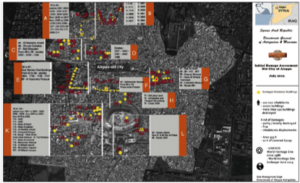
Map by DGAM, Damaged historical building in ancient city of Aleppo
A symbol of the city, the Citadel of Aleppo is its most prominent historic site. Inscribed on the UNESCO World Heritage List. Located in the centre of the Ancient City of Aleppo, it is considered the main landmark of the entire metropolis. Indeed, it holds the remains of the ancient Temple of the Storm God and it is one of the most remarkable examples of military architecture in the Middle East. The overall damage to the walls is less than 40% and so classed as moderate, the towers and wall around them in two locations have been destroyed and several of the towers have sustained heavy damage. [5]
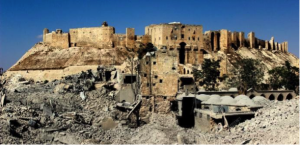
Pic: Damage to the Citadel of Aleppo during the conflict
In 2014, the city witnessed a huge explosion that destroyed the Carlton Hotel – the Citadel, a building dating back to the early twentieth century, located near the ancient Aleppo Citadel and next to its markets.
The Umayyad Mosque in Aleppo, which dates back to the eighth century AD, was heavily damaged as a result of the violent battles that took place in and around it. It was destroyed by terrorists in 2013 after rigging it with explosives with the aim of destroying this great heritage of the city.
The minaret was destroyed during fighting in April 2013. In September 2012, a huge fire in the covered suqs damaged much of the eastern side of the mosque and destroyed the library. In addition, the stone-tiled courtyard is partially destroyed. The imagery of 2015 and 2017 show additional damage to the eastern portico. A section of the eastern wall and the north-eastern corner of the mosque are destroyed.[6]
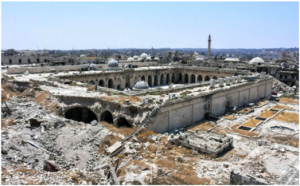
A picture taken on July 22, 2017 shows a general view of the destruction at the site of the ancient Grand Mosque in the old city. George Ourfalian / AFP
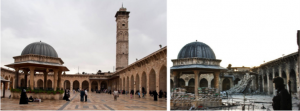
The situation of the Umayyad mosque of Aleppo before and during the war. European Scientific Journal
As for the archaeological site that had been subjected to illegal excavations, deliberate vandalism, looting and smuggling of antiquities. Here we mention the famous site of the Prophet Hori “Cyrus” which according to reports received by the General Directorate of Antiquities and Museums, the archaeological site of the Prophet Hori “Ancient Cyrus” in the Afrin region in the northern countryside of Aleppo was subjected to systematic sabotage and illegal excavations by terrorist organizations, which led to extensive damage. Because of the illegal excavation using bulldozers by terrorist groups, in order to uncover treasures and archaeological finds for looting. The terrorist organizations also destroyed the pyramidal building that includes the archaeological tomb of the Prophet Hori and the construction of a two-storey concrete building within the site next to the shrine, in addition to destroying parts of the discovered Roman house and the mosaic panel in it.
It is worth noting that the site of Al-Nabi Hori, located 70 km northwest of Aleppo, is an ancient city that was founded at the end of the 4th century BC in a checkerboard style and remained prosperous during the Roman and Byzantine eras. It includes a large distinctive amphitheatre, a castle, walls interspersed with gates, paved streets, markets, and various public and residential buildings.[7]
As same for Afrin, the region has been subjected to multiple violations and illegal excavations in search of archaeological finds, using modern equipment and in an unsystematic manner with the aim of selling archaeological finds and smuggling them outside the country. The Ministry of Foreign Affairs and Emigrants has more than once condemned the illegal excavations and excavations of antiquities in the region, considering these acts as a “war crime. It must be condemned and its perpetrators punished”.[8]
The most important of which is the Temple of Ain Dara. The plan of the temple belongs to the models of temples known as Ante-temple, which are temples with a front hall former to the prayer hall, also known as the Temple of the House. Similar examples of this model are spread in the northern sites of the Levant and northern Mesopotamia as well as the blocks of Khwira and Tel Halawa. , Ebla (Tel Mardikh) from the Middle Bronze Age, Imar, Eklta (Membaka) from the Neo-Bronze Age, and Carchemish from the Iron Age. This architectural style continued as a distinctive style in “Luwiyya-Aramaic” architecture during the Iron Age.[9]
According to the report issued by (ASOR), the date of targeting the temple was set as January 22, 2018, the temple was heavily damaged. Reports indicate that at least 60% of the construction has been reduced to rubble.[10] When viewing the photos and videos released online, one can see that the entire front facade of the temple has been destroyed. The site’s symbolic basalt lion was stolen in December. The disappearance of the Lion of Afrin marks another war crime against Syrian history and for all humanity.
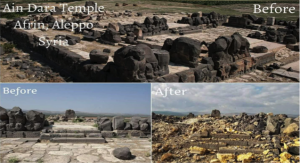
Photo by Al-Ahram Gate magazine website, Ain Dara temple before and after destruction, Afrin, Aleppo
Museum of Popular Art and Traditions (Bayt Ajiqbash)
There is clear evidence of debris around the walls, the roof of the building is heavily damaged, and a small section of it to the southeast appears to have collapsed. In 2013, the collection from the Museum of Popular Art and Traditions was moved to the National Museum of Aleppo. Bayt Ajiqbash is especially famous for its rich stone decorations, reflecting the impact of European baroque ornamental forms. In addition, the southern iwan, the qa’a and the other rooms on the ground floor were decorated with wooden panels. Taking into consideration that these elements have been severely damaged or destroyed, the overall historical loss is categorized as severe.[10]
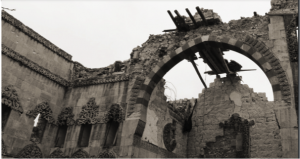
Damaged South Iwan of the Museum of Popular Art and Traditions (Bayt Ajiqbash). Picture date: 16 January 2017 © UNESCO/C. Menegazzi.
Where tangible cultural heritage in Aleppo was highly at risk, intangible cultural heritage was also jeopardized by the massive destruction of the workshops, shops, storages, and by the emigration of a large number of craftsmen outside the country. Unfortunately, a large number of people from Aleppo who fled the city also took with them the expertise inherited by their ancestors. Following the intensified conflict at the end of 2016, around 121.350 people of eastern Aleppo were registered as displaced as of 20 January 2017.
The destruction of heritage is a long-standing weapon used by one force against a people, resulting in the erasure of another culture’s identity. Used as means through which to dominate local historical narratives, suppress particular communities, and exploit resources (in the form of artifacts) for their own gain.
According to the head of the Association of Goldsmiths in Aleppo, the number of artisanal workshops working in goldsmithing decreased during the crisis from 1200 to 40 workshops only during the crisis as a result of the destruction in shops and workshops. Thus, in turn affected the community structure first, the cultural products and the craft diversity that characterizes the city of Aleppo.
And when we talk about the cultural heritage of the city of Aleppo, it is very important to talk about the traditional laurel soap, which was affected, like the rest of the crafts, by the crisis and the destruction of the Old City, where the workshops, display and sales shops were completely destroyed. And as a result of the migration of most of the skilled labor force, especially the master of soap making. This is reflected in the quality of the product. As well as the spread of fraud and imitation
Cultural heritage role in recovery
Contrary to the view that “culture must wait”, Culture and cultural heritage are the means to bring back life after conflict and war, in the form of the revival of traditions, crafts, and natural materials, which in turn reconnect people to the place and promote the values of sustainability and authenticity.
Culture and cultural heritage are powerful catalysts in overcoming the challenges of recovery and reconciliation for cities devastated by armed conflict,” said UNESCO’s Assistant Director-General for Culture, Ernesto Ottone R. “Inclusive dialogue, respect for cultural diversity and a sense of community ownership, helps cities recover from the trauma of war and secure a lasting peace.”
Just as the destruction of heritage can be used as a weapon, its preservation can be used as a tool for healing, as the reclamation or preservation of heritage can foster respect and dialogue between cultures that are experiencing continuing trauma caused by the impact of armed conflict. Links to the tangible past can be a first step towards rebuilding a community torn apart by war.
The role of cultural heritage should be recognized as an important one from the early recovery phase following a period of war or armed conflict. Actively including cultural heritage in the agenda of recovery can have a positive force both for social reconstruction and for eventual reconciliation, when it becomes a community need as a result of a shattered life.
In this regard, many efforts have been made for the restoration and the rehabilitation of the old city of Aleppo. Starting with the restoration of markets, shops and workshops, as they are the backbone of economic, social and cultural life in the old city.
The archaeological market of Al-Saqatiyah in Aleppo opened its doors to the owners of its shops and lovers of the old city of Aleppo in 2019.
The oldest covered markets of Aleppo, dating back to 1100 years ago, which includes 53 shops, was the first destination for cooperation, which included the Aga Khan Cultural Foundation, the Syrian Trust for Development, the Aleppo Governorate, and the Ministries of Culture and Tourism. It is the first among the names that the authorities will work to restore in the old markets of Aleppo.
An agreement was also signed to restore and rehabilitate the Al-Ahmadiyah market in the old city of Aleppo in accordance with local and international standards and conditions for cultural, economic, and societal rehabilitation in historical cities.[11]
Thus, the local community return to their familiar pre-war life, bringing the traditions, and cultural products back to life
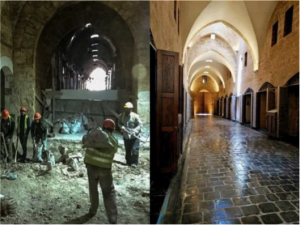
Pic by AKDN, Rehabilitation of Al-Saqatiyah Market, ancient city of Aleppo
[1] Cultural heritage in post-war recovery. ICCROM. 2005. p12
[2] Five years of conflict, the state of cultural heritage in the ancient city of Aleppo. UNESCO / UNITAR, 2018.p20
[3] Archaeological heritage in Syria during the crisis 2011-2013. 2011. page 32
[4] UNESCO reports on extensive damage in first emergency assessment mission to Aleppo.2017
[5] Five years of conflict, the state of cultural heritage in the ancient city of Aleppo. UNESCO / UNITAR, 2018. P35
[6] Five years of conflict, the state of cultural heritage in the ancient city of Aleppo. UNESCO / UNITAR, 2018. P59
[7] Report of the Syrian Arab News Agency. Significant damage to the site of the Prophet Hori.2018
[8] Report of the Syrian Arab News Agency. 2021
[9] The Arts of the Ancient Kingdoms, Ali Abu Assaf, 1993
[10] Five years of conflict, the state of cultural heritage in the ancient city of Aleppo. UNESCO / UNITAR, 2018.p96
[11] Aga Khan Cultural Services. Syria
https://www.facebook.com/groups/245462725487119/
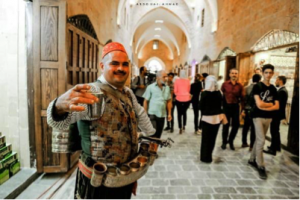
Pic by AKDN, Bringing life back to the old city of Aleppo

